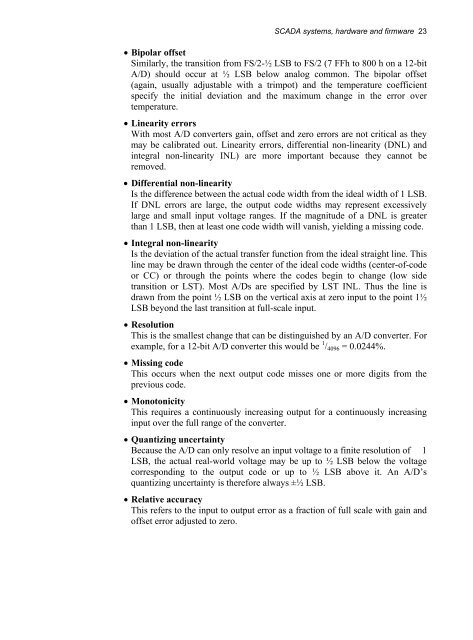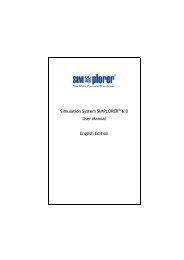- Page 1 and 2: Practical SCADA for Industry
- Page 3 and 4: Practical SCADA for Industry David
- Page 5 and 6: Contents Preface xiii 1 Background
- Page 7 and 8: Contents vii 3.6.13 Conclusion 97 3
- Page 9 and 10: Contents ix 5.4.6 10Broad36 153 5.4
- Page 11 and 12: Contents xi 7.2.2 Earthing and shie
- Page 13 and 14: 2 Practical SCADA for Industry The
- Page 15 and 16: 4 Practical SCADA for Industry PC E
- Page 17 and 18: 6 Practical SCADA for Industry •
- Page 19 and 20: 8 Practical SCADA for Industry Line
- Page 21 and 22: 10 Practical SCADA for Industry Fro
- Page 23 and 24: 12 Practical SCADA for Industry 2.2
- Page 25 and 26: 14 Practical SCADA for Industry lin
- Page 27 and 28: 16 Practical SCADA for Industry Fig
- Page 29 and 30: 18 Practical SCADA for Industry Sma
- Page 31 and 32: 20 Practical SCADA for Industry Fig
- Page 33: 22 Practical SCADA for Industry The
- Page 37 and 38: 26 Practical SCADA for Industry Dif
- Page 39 and 40: 28 Practical SCADA for Industry 2.3
- Page 41 and 42: 30 Practical SCADA for Industry Fig
- Page 43 and 44: 32 Practical SCADA for Industry Not
- Page 45 and 46: 34 Practical SCADA for Industry •
- Page 47 and 48: 36 Practical SCADA for Industry •
- Page 49 and 50: 38 Practical SCADA for Industry Fig
- Page 51 and 52: 40 Practical SCADA for Industry can
- Page 53 and 54: 42 Practical SCADA for Industry •
- Page 55 and 56: 44 Practical SCADA for Industry som
- Page 57 and 58: 46 Practical SCADA for Industry •
- Page 59 and 60: 48 Practical SCADA for Industry The
- Page 61 and 62: 50 Practical SCADA for Industry The
- Page 63 and 64: 52 Practical SCADA for Industry Fig
- Page 65 and 66: 54 Practical SCADA for Industry 2.8
- Page 67 and 68: 56 Practical SCADA for Industry Fig
- Page 69 and 70: 58 Practical SCADA for Industry The
- Page 71 and 72: 60 Practical SCADA for Industry Exc
- Page 73 and 74: 62 Practical SCADA for Industry •
- Page 75 and 76: 3 SCADA systems, software and proto
- Page 77 and 78: 66 Practical SCADA for Industry •
- Page 79 and 80: 68 Practical SCADA for Industry Fig
- Page 81 and 82: 70 Practical SCADA for Industry A l
- Page 83 and 84: 72 Practical SCADA for Industry 3.3
- Page 85 and 86:
74 Practical SCADA for Industry •
- Page 87 and 88:
76 Practical SCADA for Industry Fig
- Page 89 and 90:
78 Practical SCADA for Industry The
- Page 91 and 92:
80 Practical SCADA for Industry ‘
- Page 93 and 94:
82 Practical SCADA for Industry 3 D
- Page 95 and 96:
84 Practical SCADA for Industry Sig
- Page 97 and 98:
86 Practical SCADA for Industry TRA
- Page 99 and 100:
88 Practical SCADA for Industry 3.6
- Page 101 and 102:
90 Practical SCADA for Industry Two
- Page 103 and 104:
92 Practical SCADA for Industry 3.6
- Page 105 and 106:
94 Practical SCADA for Industry Sen
- Page 107 and 108:
96 Practical SCADA for Industry Fig
- Page 109 and 110:
98 Practical SCADA for Industry 3.7
- Page 111 and 112:
4.1 Introduction 4 Landlines Landli
- Page 113 and 114:
102 Practical SCADA for Industry Th
- Page 115 and 116:
104 Practical SCADA for Industry Th
- Page 117 and 118:
106 Practical SCADA for Industry To
- Page 119 and 120:
108 Practical SCADA for Industry Fi
- Page 121 and 122:
110 Practical SCADA for Industry S
- Page 123 and 124:
112 Practical SCADA for Industry 4.
- Page 125 and 126:
114 Practical SCADA for Industry 4.
- Page 127 and 128:
116 Practical SCADA for Industry Th
- Page 129 and 130:
118 Practical SCADA for Industry Fi
- Page 131 and 132:
120 Practical SCADA for Industry A
- Page 133 and 134:
122 Practical SCADA for Industry If
- Page 135 and 136:
Figure 4.21 Telemetry installation
- Page 137 and 138:
126 Practical SCADA for Industry di
- Page 139 and 140:
128 Practical SCADA for Industry te
- Page 141 and 142:
130 Practical SCADA for Industry Si
- Page 143 and 144:
132 Practical SCADA for Industry 4.
- Page 145 and 146:
134 Practical SCADA for Industry Th
- Page 147 and 148:
136 Practical SCADA for Industry Th
- Page 149 and 150:
138 Practical SCADA for Industry At
- Page 151 and 152:
140 Practical SCADA for Industry ch
- Page 153 and 154:
5 Local area network systems 5.1 In
- Page 155 and 156:
144 Practical SCADA for Industry Fi
- Page 157 and 158:
146 Practical SCADA for Industry Fi
- Page 159 and 160:
148 Practical SCADA for Industry by
- Page 161 and 162:
150 Practical SCADA for Industry
- Page 163 and 164:
152 Practical SCADA for Industry bu
- Page 165 and 166:
154 Practical SCADA for Industry th
- Page 167 and 168:
156 Practical SCADA for Industry to
- Page 169 and 170:
158 Practical SCADA for Industry as
- Page 171 and 172:
160 Practical SCADA for Industry
- Page 173 and 174:
162 Practical SCADA for Industry Fi
- Page 175 and 176:
164 Practical SCADA for Industry 5.
- Page 177 and 178:
166 Practical SCADA for Industry B
- Page 179 and 180:
168 Practical SCADA for Industry If
- Page 181 and 182:
170 Practical SCADA for Industry 5.
- Page 183 and 184:
172 Practical SCADA for Industry co
- Page 185 and 186:
174 Practical SCADA for Industry vi
- Page 187 and 188:
6.1 Introduction 6 Modems This chap
- Page 189 and 190:
178 Practical SCADA for Industry 6.
- Page 191 and 192:
180 Practical SCADA for Industry 6.
- Page 193 and 194:
182 Practical SCADA for Industry ed
- Page 195 and 196:
184 Practical SCADA for Industry At
- Page 197 and 198:
186 Practical SCADA for Industry
- Page 199 and 200:
188 Practical SCADA for Industry A
- Page 201 and 202:
190 Practical SCADA for Industry 6.
- Page 203 and 204:
192 Practical SCADA for Industry Th
- Page 205 and 206:
194 Practical SCADA for Industry Fi
- Page 207 and 208:
196 Practical SCADA for Industry Th
- Page 209 and 210:
198 Practical SCADA for Industry 6.
- Page 211 and 212:
200 Practical SCADA for Industry Th
- Page 213 and 214:
202 Practical SCADA for Industry 6.
- Page 215 and 216:
204 Practical SCADA for Industry Fi
- Page 217 and 218:
206 Practical SCADA for Industry Th
- Page 219 and 220:
208 Practical SCADA for Industry
- Page 221 and 222:
210 Practical SCADA for Industry Fi
- Page 223 and 224:
7 Central site computer facilities
- Page 225 and 226:
214 Practical SCADA for Industry 7.
- Page 227 and 228:
216 Practical SCADA for Industry 7.
- Page 229 and 230:
218 Practical SCADA for Industry Di
- Page 231 and 232:
220 Practical SCADA for Industry
- Page 233 and 234:
222 Practical SCADA for Industry Ty
- Page 235 and 236:
224 Practical SCADA for Industry An
- Page 237 and 238:
226 Practical SCADA for Industry
- Page 239 and 240:
228 Practical SCADA for Industry
- Page 241 and 242:
230 Practical SCADA for Industry 8.
- Page 243 and 244:
9.1 Introduction 9 Specification of
- Page 245 and 246:
234 Practical SCADA for Industry wo
- Page 247 and 248:
236 Practical SCADA for Industry On
- Page 249 and 250:
238 Practical SCADA for Industry Am
- Page 251 and 252:
240 Practical SCADA for Industry ad
- Page 253 and 254:
242 Practical SCADA for Industry CR
- Page 255 and 256:
244 Practical SCADA for Industry Dr
- Page 257 and 258:
246 Practical SCADA for Industry Fi
- Page 259 and 260:
248 Practical SCADA for Industry In
- Page 261 and 262:
250 Practical SCADA for Industry Mo
- Page 263 and 264:
252 Practical SCADA for Industry Pe
- Page 265 and 266:
254 Practical SCADA for Industry Se
- Page 267 and 268:
256 Practical SCADA for Industry Tr
- Page 269 and 270:
PIN NO 1 2 3 4 5 6 7 8 9 Appendix B
- Page 271 and 272:
260 Practical SCADA for Industry 1
- Page 273 and 274:
Objective Appendix C CITECT practic
- Page 275 and 276:
264 Practical SCADA for Industry De
- Page 277 and 278:
266 Practical SCADA for Industry An
- Page 279 and 280:
268 Practical SCADA for Industry Bu
- Page 281 and 282:
270 Practical SCADA for Industry Se
- Page 283 and 284:
Accumulator 29 counter specificatio
- Page 285 and 286:
COM port 7 Common mode rejection ra
- Page 287 and 288:
enclosure 213 power connections 214
- Page 289 and 290:
ead-only access 173 standard web br
- Page 291 and 292:
token ring 147 token-passing proces
- Page 293 and 294:
sinusoidal signal 193 technique 181
- Page 295 and 296:
multi-master mode 88 physical layer
- Page 297 and 298:
data communication system 6 disadva
















